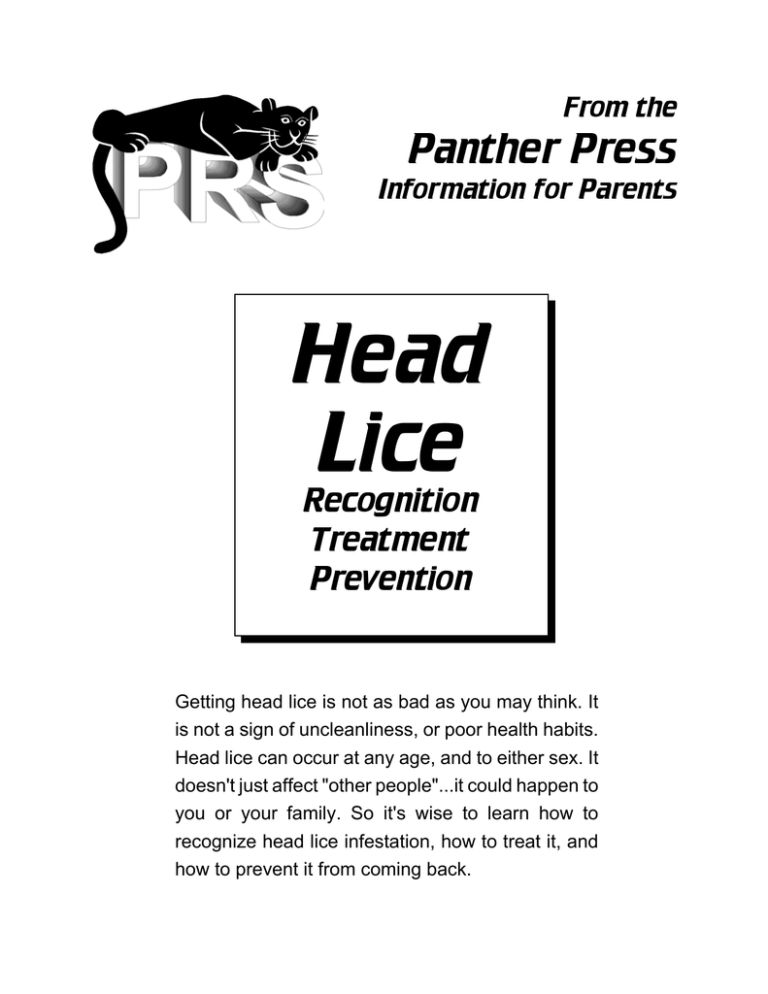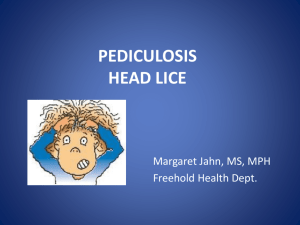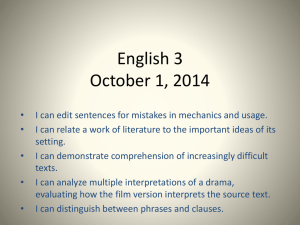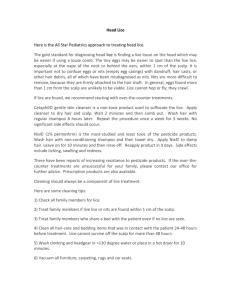Head Lice Panther Press Recognition
advertisement

From the Panther Press Information for Parents Head Lice Recognition Treatment Prevention Getting head lice is not as bad as you may think. It is not a sign of uncleanliness, or poor health habits. Head lice can occur at any age, and to either sex. It doesn't just affect "other people"...it could happen to you or your family. So it's wise to learn how to recognize head lice infestation, how to treat it, and how to prevent it from coming back. Lousology 101 - The Biology of Head Lice Nits • • • • • • • • Are small yellowish-white oval shaped eggs that are glued on at an angle to the side of a hair shaft with an extremely strong substance Must be laid by live lice Take 7 to 10 days to hatch Hatched nymphs feed immediately- at the first nymph stage, nymphs are very small and look like specks of pepper Once hatched, nymphs take 7 to 10 days to reach maturity and begin laying nits Lice will vary in colour from off-white to brown and are slightly smaller than a sesame seed They are always the same shape but will grow slightly in size Most commonly found above/behind the ears along the hair line at the neck and on the crown of the head Please Note: Nit removal becomes the only objective marker for schools to determine a completed lice elimination process. Head Louse • is a small wingless insect that feeds on human blood and needs human blood in order to survive • it is clear in colour when hatched then quickly develops a reddish/brown colour after feeding • • • • • • about the size of a sesame seed has 6 legs equipped with claws to grasp the hair it is a very active, fast crawling insect but does not jump or fly it cannot live on pets lives approximately 30 days on its human host and may lay up to 100 eggs it will live anywhere from 12 to 48 hours when off its human host Treating Head Lice–The Sooner the Better Step #1--Use Insecticidal Shampoo This is required to kill the live lice. Make sure to follow package instructions and do not dilute the shampoo. Step #2–Remove the Nits To facilitate removal of nits, use a 50:50 solution of mineral oil and vinegar. Massage the solution into the hair and cover for one hour with a shower cap. Shampoo out with regular shampoo. Use regular comb, to comb out tangles and then use special nit comb to remove nits by handling hair one section at a time. Not all nits are removed with the nit comb. To ensure all removal of nits, they may have to be picked one at a time from the hair shaft manually. Tips for Manual Removal Work under a good light. Strong, natural sunlight appears to be the most effective. Divide the hair into sections and fasten off the hair that is not being worked on. Remove individual nits individually with thumb and forefinger by pulling along the hair shaft. Please Note: • Nits can be laid anywhere close to the scalp to a little further along the hair shaft. • If additional nits are found 3 to 5 days later, this may signal live lice on the head. Another thorough manual search is recommended. • Daily screening is vital for anything that may have been missed and for identification of a new infestation as early as possible. Step #3–Clean the environment Machine wash all personal items such as clothes, bed linens, towels in very hot water and dry at least 20 minutes in hot dryer. Store all other exposed items in a large plastic bag for 2 weeks or dry clean. Vacuum all affected areas including mattresses, sofas, cushions, pillows, teddy bears. Wrap vacuum bag and contents in plastic bag and discard. Disinfect combs and brushes by soaking them in very hot water for 15 minutes. Should other family members or roommates be checked for head lice? Yes. If one member of a residence has head lice, all members should be inspected periodically for two weeks. If lice or nits are found, they should be treated promptly. (See prevention section) Prevention 1. Watch for signs of head lice, such as frequent head scratching. Anyone can get head lice ... mainly by head to head contact but also from sharing hats, brushes and headrests. Lice do not jump or fly. 2. Check all family members for lice and nits (lice eggs) at least once a week. Only those infested should be treated. Lice are reddish-brown wingless insects; nits are grayish-white, always oval shaped, and are glued at an angle to the side of the hair shaft. 3. Be sure not to confuse nits with hair debris such as bright white irregularly-shaped clumps of dandruff stuck to the hair shaft or elongated segments of dandruff encircling the hair shaft and easily dislodged. Lice treatment is not appropriate for hair debris. And finally....... if your child checks positive......please remember to notify your child's school, camp, child care provider and neighbourhood parents. Check for lice on a regular basis. This is the best way to protect your family and community





